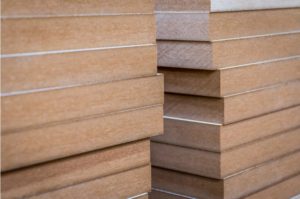A Comprehensive Guide To MDF Boards
Popularly known as MDF, medium-density fibreboards present a cheap and durable material when executing woodworking projects. This material significantly outshines the versatility and affordability of similar wood products such as plywood and for a good reason.
 Unlike your conventional timber, MDF wood has no grains or knots and doesn’t warp. It also boasts a smooth surface that makes it easy to work with. Below is a comprehensive overview of the MDF.
Unlike your conventional timber, MDF wood has no grains or knots and doesn’t warp. It also boasts a smooth surface that makes it easy to work with. Below is a comprehensive overview of the MDF.
How Are MDF Boards Made?
MDF is categorised in a group of hardboard products that are comprised of bits and pieces of wood such as shavings and sawdust, which are essentially by-products of milling. These pieces are first dried and then mixed with wax and resin to form panels. Subsequently, the panels are compressed under intense heat and pressure. This treatment affords them sufficient rigidity and a hard shell with a smooth finish.
How Are They Sold?
MDF wood is often available in tan or chocolate brown colours. These boards are often manufactured in dimensions ranging between 8ft -25ft long and a thickness of a 1\4 to 1 inch. If you’re contemplating using the boards for home woodwork projects, you can find boards having 1\2 inch to 3\4 inch thicknesses from Theo’s Timber Ltd. It’s also important to note that MDF boards come with standard stamps that are used to indicate their properties. For instance, a red or blue stamp implies that the board in question is fire resistant while a green mark means that the MDF is resilient to moisture.
What Are The Common Uses Of MDF?
MDF wood is ranked among the most versatile carpentry material and for a good reason. It’s incredibly durable, has an average density, making it an excellent choice for numerous projects like making cabinets and shelves. MDF can also be used to make speaker enclosures, shoe storage units, and furniture such as tables and benches. These boards can also be used for decorative purposes like creating home trims, which is attributable to their smooth surface that’s perfect for painting.
Do I Need Special Skills or Tools?
Using MDF on your woodworking projects is very similar to working with wood. This means that you don’t need any special skills other than those associated with basic carpentry. You are, however, required to use a power nailer or a drill to drive in the nails or screws. This is because using a hammer to drive in the nail may damage the MDF. When making closets, shelves or cabinets, it would be a point plus if you added a strip on the underside of the boards to avoid sagging.
Medium-density fibreboard is an incredible woodworking material that is essentially more versatile and aesthetically appealing than plywood. These boards comprise of sawdust and wood shavings, which are compressed together to form robust panels. Such panels can be used to create speaker enclosures, cabinets, shelves, and furniture not to mention soundproofing.
